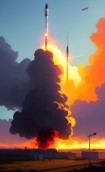|
Kemper Boyd posted:The latter. Battle of Samar certainly proved how poor they fared when confronted with a real enemy. On the other hand escort carriers certainly saved convoys from U-boats. Don't put them into dumb roles and small carriers can be useful. The idea behind the US helicopter carriers is that they can quickly provide support to infantry during an amphibious assault while the big carriers establish air superiority. That seems reasonable enough.
|
|
|
|

|
| # ? Jun 8, 2024 04:07 |
|
Koorisch posted:I believe I read something about because the fuel was missing an antistatic chemical or something like that, I don't know anything about jet-fuel compositions so I have no idea what exactly that does. Probably prevents the fuel from igniting if handled wrong / by people wearing stuff or using equipment that is not EX-certified.
|
|
|
|
Pimpmust posted:Probably prevents the fuel from igniting if handled wrong / by people wearing stuff or using equipment that is not EX-certified. Or possibly something like making it less capable of busting into flame if something hit the fuel tank, of course that's only with weapons not capable of blowing it up in a single shot like say, a missile or something.
|
|
|
|
iyaayas01 posted:Keep requirements reasonable and don't allow requirements creep. Also limit multi-role/function poo poo to the bare minimum necessary. Budget realistically but appropriately. Set appropriate and realistic milestones and hold the contractor to those milestones. 90% solutions on time and under budget are better than 150% solutions a decade late and at 75% cost overruns.... Very interesting. Thanks. Regarding 90% solutions: My understanding of the F4U Corsair is that it was designed for carrier use, didn't cut it to the Navy's satisfaction, and ended up being an outstanding USMC land based fighter/bomber while the bugs were worked out. Basically the Marines went with a folding, inverted gull-wing Navy reject rather than keep the F4F and hold out for something better. I have to assume project management has gotten better since the 30's- the tools engineers have to work with have definitely gotten better, but it does seem to me that the political and technical complexities of developing modern aircraft has outstripped those advantages. Popular perception seems to be that the acquisitions process is overall delivering worse outcomes than it used to. Is this true? Or is it the case that because the F-35 is the most heavily scrutinized aerospace project since Apollo (or so it appears), we have a false notion of how relatively pain free other projects were?
|
|
|
|
JP-5 is Navy fuel, it has a higher flash point so as to be less of a fire hazard on an aircraft carrier. (Because despite all the sea water around, fires are much worse news on a boat than on the ground.) But it does not contain antistatic agents. The static in antistatic is static electricity, they are meant to prevent buildup of static electricity that could randomly create a spark and ignite fuel vapors in the tank.
|
|
|
|
The main problem with a lot of combat aircraft acquisitions programs are that they're frequently associated with very high technical risks (that is, using completely new and untried technology for the first time). Especially in the US with its long history of spectacular aircraft there seems to be a conviction that you have to have it all and that all problems can be solved just by more engineering (and surprisingly often they can, if you just throw enough money at it). One exception to this is the F-16, where there seems to have been some actual restraint involved.
|
|
|
|
hobbesmaster posted:Battle of Samar certainly proved how poor they fared when confronted with a real enemy. On the other hand escort carriers certainly saved convoys from U-boats. Don't put them into dumb roles and small carriers can be useful. The idea behind the US helicopter carriers is that they can quickly provide support to infantry during an amphibious assault while the big carriers establish air superiority. That seems reasonable enough. The problem with Samar wasn't so much that Escort carriers were bad, it was moreso that escort carriers didn't have the bombs/ammunition that full-bore carriers had for their planes loaded. They were mainly focused on ground targets and had the armor piercing bombs and torpedoes needed to go against battleships in storage.
|
|
|
|
Wasn't there an incident with some Swiss evaluation stating that the Gripen was basically hot garbage getting leaked a while back?
|
|
|
|
Mr. Showtime posted:Wasn't there an incident with some Swiss evaluation stating that the Gripen was basically hot garbage getting leaked a while back? It's not American so you have to be hearing things.
|
|
|
waitwhatno posted:OK, I'm really curious. Why do marines need their own aircraft carriers and planes? Why can't they request support from a navy carrier or an airforce base? Please don't say bureaucracy, because there certainly must be better solutions than giving them their own carriers. A lot of the basic elements have been answered here, but there really aren't any better solutions to the problem of having a rapid-response unit that has integrated armor, artillery, logistical ability, airpower, and sealift capabilities without having something like the USMC as a separate service. For comparison, the main independently deployable unit of the US Army is the Brigade Combat Team, which consists of three motorized, mechanized, or combined armored/mechanized battalions with supporting artillery, recon, engineering, and command/support battalions. Army Aviation may be assigned to support individual battalions, but is not integrated with BCTs and the Air Force is not integrated until the corps or theater level is organized. The main independently deployable unit of the USMC, in theory, is the Marine Expeditionary Unit, which consists of roughly two battalions and incorporates armor, artillery, airpower, logistics, and command units, and nowadays is always deployed with naval support alongside sealift capacity (these are under Navy control, of course). The Brigade Combat Team is also a recent development where the MEU is somewhat more venerable. Of course, you could argue over how useful the MEU really is compared to the BCT (or how effective the MEB, its bigger brother is compared to the BCT) , and many people have. On the other hand, from the point of view of empire, having all your military prowess on display bar carriers and heavy bombers is probably well worth somewhat lesser combat capabilities, and there is the cultivated reputation of the USMC as an elite fighting force as well.
|
|
|
|
|
Party Plane Jones posted:The problem with Samar wasn't so much that Escort carriers were bad, it was moreso that escort carriers didn't have the bombs/ammunition that full-bore carriers had for their planes loaded. They were mainly focused on ground targets and had the armor piercing bombs and torpedoes needed to go against battleships in storage. The escort carriers were valuable for letting fleet carriers focus on maritime operations during non-peak times but were most certainly a luxury of having the largest shipbuilding capacity and economy in the world. If you were short on money they would not be far off the first things to cut. The problem is that the kind of ships that were very well suited to carrier conversions were not very common after the 20s and converting smaller ships gives you the Japanese light carriers. The superior range of Japanese fighters allowed them to stay relatively safe from land-based attack. Effectronica posted:Of course, you could argue over how useful the MEU really is compared to the BCT (or how effective the MEB, its bigger brother is compared to the BCT) , and many people have. On the other hand, from the point of view of empire, having all your military prowess on display bar carriers and heavy bombers is probably well worth somewhat lesser combat capabilities, and there is the cultivated reputation of the USMC as an elite fighting force as well. Honestly, a sane defense infrastructure would have axed the marines as a separate service in the 1947 hearings because they had a lot of problems during WW2 and a lot of them had to do with their clashing with the other command structures.
|
|
|
|
Panzeh posted:Honestly, a sane defense infrastructure would have axed the marines as a separate service in the 1947 hearings because they had a lot of problems during WW2 and a lot of them had to do with their clashing with the other command structures. The Marine Corps is the Navy's police force and as long as I am President that is what it will remain. They have a propaganda machine that is almost equal to Stalin's. RIP Harry
|
|
|
Panzeh posted:Honestly, a sane defense infrastructure would have axed the marines as a separate service in the 1947 hearings because they had a lot of problems during WW2 and a lot of them had to do with their clashing with the other command structures. Yeah, but what we got was an effectively unlimited mandate for their use, blowing them up into a self-justifying system.
|
|
|
|
|
And now the navy's army's navy's carriers need a fighter that can take off vertically.
|
|
|
|
Mr. Showtime posted:Wasn't there an incident with some Swiss evaluation stating that the Gripen was basically hot garbage getting leaked a while back? Not really. The Swiss Air Force evaluated the three eurocanards. The Rafale and the Eurofighter had better performances, while the Gripen was for most operations just below the threshold they had fixed. But when you take into account that most of the Swiss Air Force requirements were kind of absurd for the country (Switzerland is not going to be attacked; it's entirely surrounded by friendly NATO countries; and Switzerland is not going to attack, they pride themselves too much on their tradition of neutrality and pacifism for that), then it made sense to ignore the SAF's requirements and look into what they'd really do with their jets: air police for the occasional errant aircraft. The Gripen is already overkill for that.
|
|
|
|
Mr. Showtime posted:Wasn't there an incident with some Swiss evaluation stating that the Gripen was basically hot garbage getting leaked a while back? It scored lower than the other two Eurocanards, yes. The metrics are very hard to understand though and a lot of capabilities they estimated on paper since the E version of the Gripen that they wanted to buy didn't actually exist yet (it'll fly for the first time this year). This was apparently to the detriment of the Gripen in particular; I haven't read the entire report myself but according to Swedish defense bloggers the score you got for a particular capability was reduced if didn't exist in reality yet, in an attempt to compensate for technical risks and manufacturers promising more than they could deliver. Normally I'd translate this myself but I'm at work so have a Google translate: quote:Significant origin to the Gripen's reputation as a worse choice is leaked parts of an evaluation report from 2009 in which the Gripen's future capabilities are greatly reduced due to risk factors in a way that made the thought-system improvements have not been fully reflected in the technical analysis. In short: the more functionality you prove the more points you get to keep. Reduction method has not been explained in the media OHT. At that time not many decisions made about subsystems on a possible future Gripen risk factors were considered high in relative terms other subsystems. Over time the focus on the future configuration and development with associated test operations dispelled uncertainties. When the final report came and decisions were taken for the Gripen in November 2011 that was not the airplane characteristics reduced to the same extent, since the risks are now considered to be lower by the evaluation team. Someone leaked report from the final report has never appeared in the media - probably because it did not point to the same conclusions as the first one. Swiss defense ministry has, however figured the end result Griffin got 2011, which shows that the system meets the requirements. The full 2009 report is here if you want to read it: http://www.letemps.ch/r/Le_Temps/Quotidien/2012/02/13/Suisse/Textes/gripen.pdf TheFluff fucked around with this message at 10:37 on Jan 13, 2015 |
|
|
|
That certainly explains why the F-35 wasn't even in the running: it effectively only exists on paper.
|
|
|
|
Panzeh posted:The problem is that the kind of ships that were very well suited to carrier conversions were not very common after the 20s and converting smaller ships gives you the Japanese light carriers. The superior range of Japanese fighters allowed them to stay relatively safe from land-based attack. Just as a clarification, the USN commissioned three types of carriers during the war. Fleet carriers (CV and CVB,) Light carriers (CVL,) and Escort carriers (CVE.) CVs and CVBs were built from the keel up as aircraft carriers (except the Lexington and Saratoga, which were converted from Battlecruisers. The Midway class was designated CVB, but didn't commission until after the end of the war.) The nine Independence class CVLs were converted from Cleveland class light cruisers while still on the slipways, which gave them speed almost equal to the fleet carriers. The two Saipan class CVLs were based on heavy cruiser hulls, but were laid down as carriers, so they had additional optimizations for that task. Neither commissioned before the end of the war. These ships are the reason you'll sometimes hear of late-war carrier task forces referred to as "fast carriers," since they weren't necessarily all fleet carriers, but could all operate cohesively. The six classes of escort carriers were all based on various types of merchant ships, which meant that they were cheap, but also small, and more critically, slow. Instead of the 31-33kts of the fast carriers, they were only capable of 15-18kts. More than enough to escort convoys or amphibious forces, or to park offshore of a pacific island and blow the hell of it, but insufficient to keep up with the main body of the battle fleet. It also severely limited their ability to operate aircraft, and escort carriers carried almost exclusively F4Fs in their air wings through the end of he war, and the embarked TBF/TBMs were unable to operate from them while carrying their primary anti-ship weapon, the Mk 13 aerial torpedo. The RN operated significant numbers of US-built escort carriers. The Japanese light carriers were analogous to the US Light carriers, and could operate alongside the fleet carriers. This does not, of course, mean that the previously mentioned issues with air wing size didn't apply; light carriers were merely a way to augment a task force, and weren't particularly well suited to operating on their own.
|
|
|
|
Would it make sense to axe 3 amphibs, replace them with Charles de Gaulle style mid sized carriers, and stuff the remaining amphibs full of helicopters and landing craft so the USMC can satisfy its hardon for fast jets without making everyone else's planes shittier?
|
|
|
|
blowfish posted:Would it make sense to axe 3 amphibs, replace them with Charles de Gaulle style mid sized carriers, and stuff the remaining amphibs full of helicopters and landing craft so the USMC can satisfy its hardon for fast jets without making everyone else's planes shittier? Just figure out a way to bolt some bombs and a targeting pod to an osprey and call it a day.
|
|
|
|
Riso posted:That certainly explains why the F-35 wasn't even in the running: it effectively only exists on paper. There are more F-35s than Rafale Fighters at this point.
|
|
|
|
hobbesmaster posted:Just figure out a way to bolt some bombs and a targeting pod to an osprey and call it a day. The Osprey is neither fast nor a jet  still more sensible than the F-35B though. On second thought, the Marines would need 5 CDGs: two each on the eastern and western side of the US so one can be in drydock without compromising the ability to go trash a third world airforce any day of the week, plus a spare just in case. Leave 5 amphibs, maybe 7 for the capability to go shock and awe a third world army any day of the week. At this point, the US Navy's Army's Navy could probably win a sea battle against all of Europe 
suck my woke dick fucked around with this message at 23:52 on Jan 13, 2015 |
|
|
|
blowfish posted:Would it make sense to axe 3 amphibs, replace them with Charles de Gaulle style mid sized carriers, and stuff the remaining amphibs full of helicopters and landing craft so the USMC can satisfy its hardon for fast jets without making everyone else's planes shittier? The Charles de Gaulle is actually quite similar in size and aircraft capacity to the American Wasp- and America-class assault carriers. The biggest difference is that the CDG has a CATOBAR system (catapults and wire traps) that allows it much greater flexibility in launching and recovering aircraft. CATOBAR-launched aircraft are therefore simpler to operate, have lower maintenance and operational costs, and can carry more weight (with the associated range/payload benefits). And we're developing a new electrically-driven system called EMALS that is more powerful and reliable. It would be nominally quite possible to install an EMALS system onto the existing fleet - and particularly in the new Americas that are yet to be built - at a cost of about $360 - $400 million per ship (that's two catapults, one for each ramp). There's some debate about the various merits of STOVL carriers (generally centered on a comparison of surge sortie rates and the capabilities of STOVL fighters to transition to rudimentary airfields) but personally I think that the US Navy has shown that the diversity of benefits of CATOBAR carriers are well-worth the investment. Beyond all that, there's also the option of so-called STOBAR operations, where aircraft take-off under their own power (sometimes with the advantage of a carrier ski-ramp) and then land using a wire trap system. Lockheed has at times insisted that not only does the F-35 series have this capability, but that the F-35B would generally land conventionally regardless in order to reduce maintenance requirements. This was no doubt related to the UK's interest in that capability, and doubts as to the F-35B program. Lockheed has since quieted about that capability, perhaps because it calls into question the entire value of the F-35B STOVL system, but it seems quite likely that if the F-35A can do conventional landings, the F-35B can do a short take-offs, and the F-35C can do arrested recoveries, then it's likely that all three of them probably share those capabilities. In brief, I think that the US Navy's assault carriers are quite capable of fielding small aviation wings as effectively as a Charles de Gaulle light carrier, and are simply being limited by the fixation on using STOVL technology. In my opinion, STOVL fixed-wing aircraft will eventually be considered ineffective conceptual dead-ends, much as we have relegated variable sweep-wings to the technological dust-bin. The compromises required and expensive maintenance requirements outweigh the prospective benefits of the technology. At the end of the day, the idea is focused around carrying extra thrusters that are just used for landing, as well as lots of moving parts - and those are never going to be great options. Kaal fucked around with this message at 04:26 on Jan 14, 2015 |
|
|
|
Kaal posted:The Charles de Gaulle is actually quite similar in size and aircraft capacity to the American Wasp- and America-class assault carriers. The biggest difference is that the CDG has a CATOBAR system (catapults and wire traps) that allows it much greater flexibility in launching and recovering aircraft. CATOBAR-launched aircraft are therefore simpler to operate, have lower maintenance and operational costs, and can carry more weight (with the associated range/payload benefits). And we're developing a new electrically-driven system called EMALS that is more powerful and reliable. It would be nominally quite possible to install an EMALS system onto the existing fleet - and particularly in the new Americas that are yet to be built - at a cost of about $360 - $400 million per ship (that's two catapults, one for each ramp). There's some debate about the various merits of STOVL carriers (generally centered on a comparison of surge sortie rates and the capabilities of STOVL fighters to transition to rudimentary airfields) but personally I think that the US Navy has shown that the diversity of benefits of CATOBAR carriers are well-worth the investment. This is a really good post, though STOVL will remain in service till like 2060 at least unless the UK ponies up another couple of billions to upgrade their poo poo carriers (but did you know they will be longer than the Houses of Parliament) 
|
|
|
|
I think that it's quite interesting and revealing to consider STOVL as a technology separate from the procurement difficulties of the F-35 project. I mean it is such a relic of the Cold War - it was conceptually founded on the idea of small, isolated units of British fighter jets that could operate from car parks and farmer's fields after nukes had taken out their airbases. And the validity of the concept struggles to clear even that first hurdle - I mean is it seriously credible to believe a post-nuclear Britain could readily supply such a patchwork force with fuel and ammunition? And what's wrong with using, you know, a highway instead? The prospective benefits of the system for such a niche use (which obviously was never used) were clearly insufficient when compared to the drawback of being completely unable to land conventionally - a capability that would have been used every time a Harrier left the ground. And Harrier pilots have certainly paid in blood for that capability gap. But of course the Harrier did not die with the fall of the Soviet empire, but instead took on a new life upon the sea in the 1970s and 1980s with the advent of European military austerity. The British fleet was aging, and the public did not have any particular interest in buying new large capital ships like fleet carriers. So the British Navy, in a PR stunt much like America's later trickery with their so-called "Super Hornet Upgrade", decided to build "cruisers" that just so happened to have large flat decks that STOVL jets could base on. But they certainly couldn't be carriers, because there weren't any cats or traps! How convenient! The Harrier was pressed into service, despite never having been intended for sea deployments, and the partnership between the Sea Harrier STOVL jet and the Invincible escort-cruiser (later admitted to be an aircraft-carrier) was born. The US Marine Corps, eyeing the success of the idea, picked up on it and carried the ball even further - developing a new American version of the Harrier jump jet and using it to quietly justify the deployment of a bunch of not-quite-aircraft-carriers of their own. The significant design concessions meant that both training and deployment were plagued with operational issues, but those concerns were largely dismissed as the cost of progress. The US Navy objected that the Harriers were basically pilot-killing money pits, but the press chalked up the whole business as nothing more than interservice rivalry (and to be honest, they weren't far off on that assessment) and were all too happy to wow the public with pictures and video of floating jets. Now even though the program started as little more than a bureaucratic football match, there was something of a good outcome to the pairing of Harrier STOVLs with publicly acceptable escort carriers. Namely, the UK Royal Navy and the US Marine Corps had inadvertently developed a handy method for building small aircraft carriers without having to figure out how to shrink down the massive requirements of a fleet carrier. And while the STOVL jets might not be as effective, reliable, or numerous as traditional naval aviation, they were a whole lot cheaper to deploy. More NATO countries could afford to field carriers, and the US could make lots of them and park them all over the world. And so it was on this hook of technological affordability that STOVL advocates were able to continue their cause. So at this point we sit back and reflect on what brought us to this point: A rather dubious British Cold War plan to Stay Calm and Carry On after the nuclear apocalypse; A fairly underhanded bureaucratic maneuver to buy capital warships; An obsessive devotion to interservice rivalry by the US Marine Corps; A press media that was overawed by the sight of Western technological prowess; And some technological limitations that forced strategic compromises and ended up being politically effective. Enter the F-35B. Built as the natural successor to the aging Harrier, the F-35B was touted for the same benefits that the STOVL jets traditionally favored: It could be deployed to makeshift airstrips, it was part of a larger international program to build an affordable Joint Strike Fighter, it would ensure the continued independence of the Marine Corps, it was packed to the brim with technological gadgets, and there were many assurances that its deployment would permit newly affordable carriers for half of NATO, as well as catalyzing the effectiveness of the Marine MEU and make it the new expeditionary standard. However, much had changed since the glory days of the Harrier. The Cold War was dead and gone, and with it any reason to be basing expensive fighter jets out of parking lots or abandoned airstrips. The JSF concept, after repeatedly failing to meet goals, fell apart in disarray, seen by the global public as more of an industrial subsidy than a legitimate defense project. While the Marine Corps still strives for its bureaucratic independence, advances in field communications and a lessening in interservice rivalries has largely erased the WW2 fears that Marines would be abandoned on the battlefield by the other services. The problematic technological gadgets, while initially great PR, have proven more of an albatross for the F-35B than anything else. The affordability of the program has disappeared in the face of ballooning costs and a world that is increasingly critical of defense spending. And finally, and perhaps most critically, the technological limitations that had led to the development of STOVL carriers in the first place have largely been eliminated thanks to parallel research and development by the US Navy and Air Force. The new, high-performance jets of modernity have huge power-to-weight ratios for short take-offs, and computer automation and communication technologies have made both assisted and unassisted take-offs and landings far safer and more efficient. The normalization of in-flight refueling and battlefield orbital patrols has removed the need for frontline aircraft deployments and surge sorties. Having reached a pinnacle of technological military dominance amidst a period of global economic instability, Western bureaucrats are increasingly focusing on less flashy considerations like operational lifecycle costs, sustained sortie-payload rates, and in-flight incident reports - precisely the kind of areas where technologically complex STOVL aircraft have always suffered criticism. In short, the problems of the F-35B are not unique to the airframe, but are endemic to the entire concept of STOVL itself. It is a concept that has always struggled to maintain validity in the face of a rapidly changing world. The F-35B will eventually be deployed in some form or another, and it will find some roles for which it can be used, but much like the Harrier it will always struggle to prove that its unique capabilities - and the compromises that were made to permit them - are particularly relevant. Kaal fucked around with this message at 09:08 on Jan 14, 2015 |
|
|
|
So... Could th F-35 implode like the a-12?
|
|
|
|
ascendance posted:So... Could th F-35 implode like the a-12? Nope, the two aren't comparable.
|
|
|
|
ascendance posted:So... Could th F-35 implode like the a-12? No. The A-12 imploded before there were any prototypes built (reminder that there's already over a hundred F-35's in flying service at multiple bases in the US). Also it was for a single service, the F-35 is for all three services plus a whole bunch of other countries. Or basically: mlmp08 posted:Nope, the two aren't comparable.
|
|
|
|
ascendance posted:So... Could th F-35 implode like the a-12? The F-35 development program was built specifically to ward against that occurrence, and it would either take an extremely bold president killing the program and holding the line for a couple terms, or an honest-to-gosh aerial war that identified fundamental F-35 design failings to spike it. So basically no unless the economy completely breaks or the aliens invade.
|
|
|
|
The F-35 project is a lot of things but vaporware isn't one of them. Hell, it might be an okay jet for the price of an F-18.
|
|
|
|
Kaal posted:I think that it's quite interesting and revealing to consider STOVL as a technology separate from the procurement difficulties of the F-35 project. I mean it is such a relic of the Cold War - it was conceptually founded on the idea of small, isolated units of British fighter jets that could operate from car parks and farmer's fields after nukes had taken out their airbases. And the validity of the concept struggles to clear even that first hurdle - I mean is it seriously credible to believe a post-nuclear Britain could readily supply such a patchwork force with fuel and ammunition? And what's wrong with using, you know, a highway instead? This always puzzled me about Cold War military planning. Ok, the nuclear war starts. What kind of military operations are going to be launched after thousands of nukes detonate? The remaining poor bastards on Earth will fight a war against dysentery, famine, and cancer, not some nation thousands of miles away.
|
|
|
Rand alPaul posted:This always puzzled me about Cold War military planning. Ok, the nuclear war starts. What kind of military operations are going to be launched after thousands of nukes detonate? The remaining poor bastards on Earth will fight a war against dysentery, famine, and cancer, not some nation thousands of miles away. Actually, Russian military planning in particular was strongly predicated on the assumption that a nuclear exchange would take place in any major war, and that land battles would take place between heavily depleted forces fighting over a nuclear wasteland.
|
|
|
|
|
Rand alPaul posted:This always puzzled me about Cold War military planning. Ok, the nuclear war starts. What kind of military operations are going to be launched after thousands of nukes detonate? The remaining poor bastards on Earth will fight a war against dysentery, famine, and cancer, not some nation thousands of miles away. If there's two Americans and one Russkie left after the nukes are dropped, we have won. Bonus points if the two Americans go kill the Russian.
|
|
|
blowfish posted:If there's two Americans and one Russkie left after the nukes are dropped, we have won. Bonus points if the two Americans go kill the Russian. AKA Cold War Logic (TM).
|
|
|
|
|
Rand alPaul posted:This always puzzled me about Cold War military planning. Ok, the nuclear war starts. What kind of military operations are going to be launched after thousands of nukes detonate? The remaining poor bastards on Earth will fight a war against dysentery, famine, and cancer, not some nation thousands of miles away. A lot of it seems to also have been predicated on a mix of "we'll just wait for the premier to sleep off the vodka and pretend nothing happened." and "nobody will be crazy enough to push the button on the other side either". The closest they came to a plan involving first strike, afaik, was broadly unrealistic because they only planned for limited exchange.
|
|
|
|
Rand alPaul posted:This always puzzled me about Cold War military planning. Ok, the nuclear war starts. What kind of military operations are going to be launched after thousands of nukes detonate? The remaining poor bastards on Earth will fight a war against dysentery, famine, and cancer, not some nation thousands of miles away. There existed the possibility that World War 3 would see a limited nuclear exchange on the tactical level that wouldn't spread to a strategic level. I know that in a few US Navy wargames, team Red used tactical nukes in several instances on things like carrier groups, islands or remote battlefields and team Blue felt that responding would lead to a strategic exchange that would be worse than doing nothing. Presumably it would have been useful to have assets that could work out of that environment, but even then the usefulness seems limited to me.
|
|
|
|
Rand alPaul posted:This always puzzled me about Cold War military planning. Ok, the nuclear war starts. What kind of military operations are going to be launched after thousands of nukes detonate? The remaining poor bastards on Earth will fight a war against dysentery, famine, and cancer, not some nation thousands of miles away. I think I recall a general saying "If we must have a new Adam and Eve, I want 'em to be an American Adam and Eve!" After a certain point you're dealing with a Species Warfare mentality. You want the tattered survivors of your population to have whatever competetive advantage they can get over their innate foes. Or so goes the dubious thinking.
|
|
|
|
It always amuses me how countries and politicians always find money for a few 400bil airplanes, but then are always short in money and need to cut a few billions a year to healthcares and education.
|
|
|
|
Sometimes, like in Australia, they need to cut healthcare and education so as to buy useless planes.
|
|
|
|

|
| # ? Jun 8, 2024 04:07 |
|
Rand alPaul posted:This always puzzled me about Cold War military planning. Ok, the nuclear war starts. What kind of military operations are going to be launched after thousands of nukes detonate? The remaining poor bastards on Earth will fight a war against dysentery, famine, and cancer, not some nation thousands of miles away. The Russians were (probably still are) convinced that in the aftermath of a nuclear war, somebody would try to move in and take at least part of their territory. They have land neighbors. For them it absolutely makes sense to plan for operations following even the most brutal scenario. Keep in mind that when it's mentioned that there's ~4,000 operational nuclear weapons, that's not 4,000 cities being targeted. ICBM silos and airbase runways are also crucial targets - and those are likely to have multiple warheads assigned to each, to guard against an inaccurate reentry, a dud warhead or missile, or the assigned launch vehicle being destroyed by a first strike. So in the aftermath of a nuclear war, there would still be a lot of people who did not come under direct attack. Additionally, both the US and Russia maintain stockpiles of nuclear warheads substantially in excess of the missiles and bombers available to carry them - so any bombers that make it back, any missiles hidden away, or any surviving rocket production facilities, hold the promise of being able to drop additional nuclear weapons on the other side. I don't know if in the aftermath of a large-scale nuclear exchange, whether or not both sides would agree to consider the war over - but if either government decides on fighting the war until the other is totally destroyed, the military must have a plan for it, as they do for everything. EDIT: Please don't get me wrong; I find the thought of nuclear war terrifying, and the thought of continuing to slug it out over the broken remains of civilization is a ghastly one. Farmer Crack-Ass fucked around with this message at 17:19 on Jan 14, 2015 |
|
|


















 I CANNOT EJACULATE WITHOUT SEEING NATIVE AMERICANS BRUTALISED!
I CANNOT EJACULATE WITHOUT SEEING NATIVE AMERICANS BRUTALISED!








 :I'd like to borrow $200M
:I'd like to borrow $200M
